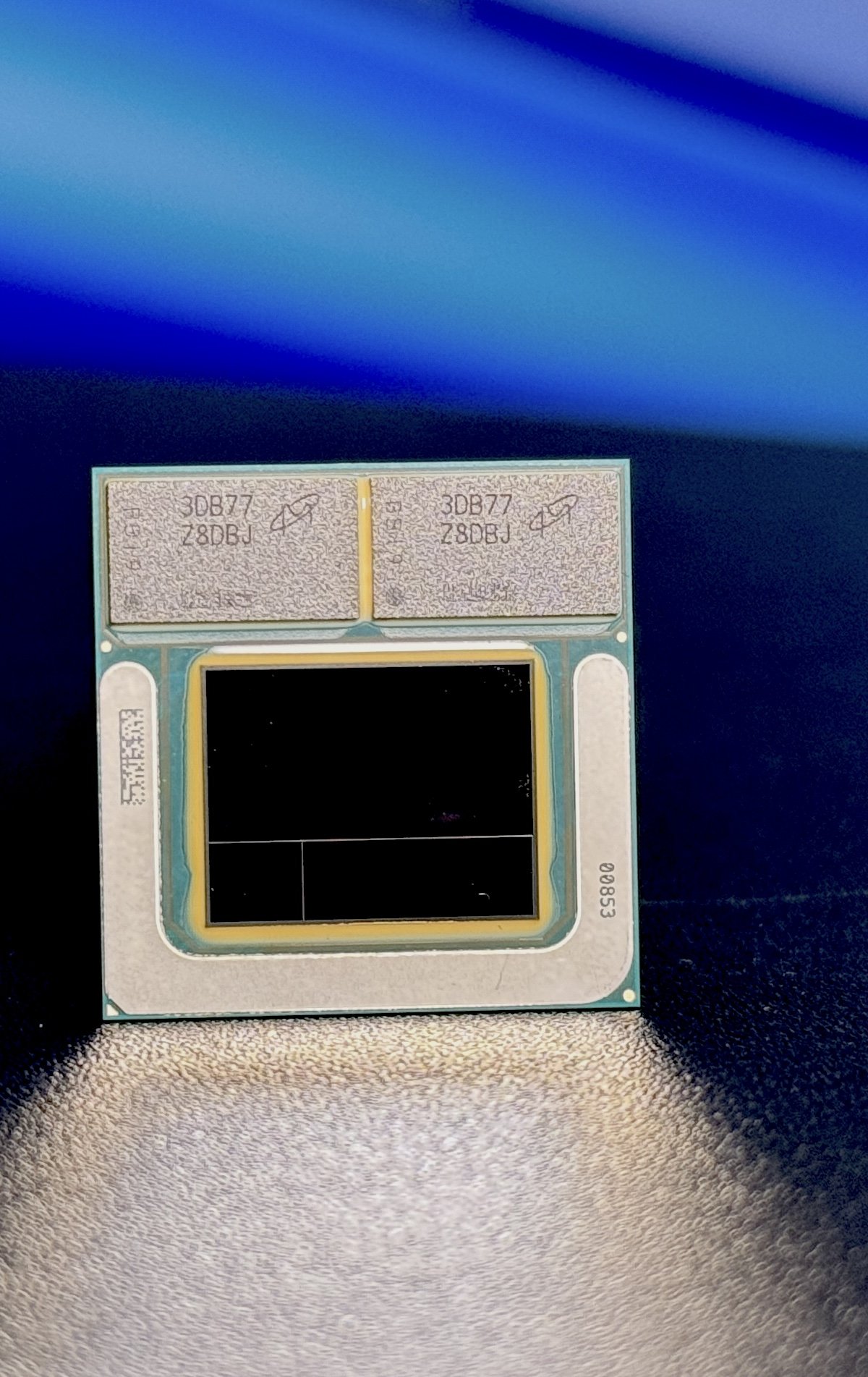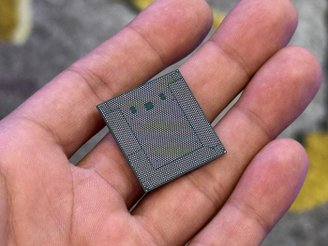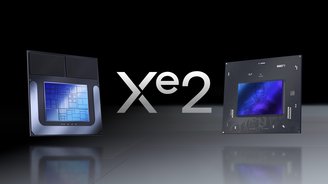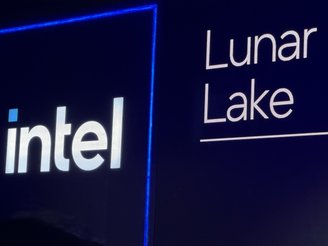
The new Lunar Intel Lake processor architecture was officially revealed this Monday (3). During Computex 2024, in Taiwan, the company revealed its plans for the future of computers. Among the highlights of the new generation, Intel reinforces the use of artificial intelligence (AI) to make notebooks more powerful and with better battery management.
The Lunar Lake generation arrives with up to 120 TOPs (Trillion Operations Per Second) of power, combining CPU, GPU and NPU:
-
GPU: there are 67 TOPs to accelerate graphics and content generation with AI;
-
NPU: there are 48 TOPs that should help, for example, in the creation and AI assistants;
-
CPU: 5 TOPs, which should handle lighter AI workloads.
Intel’s new Lunar Lake architecture is already in production and will be launched in the third quarter of 2024. (Photo: Wellington Arruda/TecMundo)
Intel’s expectations for the launch of Lunar Lake are high. During the announcement, Michelle Johnston, vice president and general manager of Intel, was emphatic in stating that the company seeks market leadership.
“We will win on performance, we will win on graphics and we will also win on AI“, quotes the executive. According to her, Lunar Lake will reformulate “everything you think about the x86 architecture and will transform the way people use their PCs with AI”.
This same statement is also reinforced by Rob Bruckner, corporate vice president at Intel. He lists three waves of advancement of artificial intelligence in the market:
-
First wave: focused on the machine learning class with a focus on versatility;
-
Second wave: brought “generative powers”, citing the example of Microsoft Copilot;
-
Third wave: should strengthen users’ skills and “transform the way we use our PCs.”
A new microarchitecture in Lunar Lake
Lunar Lake brings a new tile of computing to Intel’s product lineup. The line comes with eight cores, four of which are E-cores (Skymont), focused on efficiency, and another four P-cores (Lion Cove), focused on performance.. This is the hybrid architecture working fully, as the company mentions, to guarantee more power and efficiency. The processors also support allocated memory (LPDDR5X) with up to 32 GB in two channels, but taking up less space.
Lunar Lake performance cores feature 2.5 MB of L2 cache per core, with up to 12 MB of shared L3 cache. In the efficiency cores, there are 4 MB of shared L2 cache. This set promises, for example, to achieve greater performance without consuming as much energy, meaning notebooks can run for longer before needing a new charge..
Lunar Lake can achieve high performance without using as much energy, guarantees Intel.
 Intel Lunar Lake features a new microarchitecture focused on performance and energy consumption. (Photo: Wellington Arruda/TecMundo)
Intel Lunar Lake features a new microarchitecture focused on performance and energy consumption. (Photo: Wellington Arruda/TecMundo)
With the announcement, Intel also brings the NPU 4 to the market. The new Neural Processing Unit plays a critical role in the architecture, promising more complete workloads, improvements for integration with the operating system and applications, in addition to focusing on the multimodal structure for AI PCs.
The generational leap is big, according to Intel. The Lunar Lake NPU reaches a higher peak of operations, has a greater number of engines, achieves higher clock speeds and brings architectural improvements that should positively impact performance and efficiency. It has two computing tiles and promises to reduce energy consumption by up to 20% with machine learning and AI techniques.
-
NPU 1 (2018): peak of 0.5 TOPs;
-
NPU 2 (2021): peak of 7 TOPs;
-
NPU 3 (2023): peak of 11.5 TOPs;
-
NPU 4 (2024): 48 pTOPs.
According to the company, This new generation of AI PCs promises to deliver up to 40% lower energy consumption — compared to Meteor Lake — on the SoC (system-on-chip). Notebooks equipped with the processors should also feature better performance per core, a “giant leap” in graphics and “unparalleled AI computing”.
In terms of connectivity, on Lunar Lake we have compatibility with Wi-Fi 7, Bluetooth 5.4, Thunderbolt 4 with Thunderbolt Share and PCI Express 5.0.
Intel’s roadmap includes the launch of the Lunar Lake generations in the third quarter and Arrow Lake in the fourth quarter. For 2025, the company should launch the Panther Lake line.
Most Powerful Gaming Laptops
Another important improvement highlighted by Intel is the new Xe2 GPU. She promises a performance jump of more than 80% with games and more than five times for AI applications compared to the previous generation. Its architecture should also improve the use of displays and media playback on devices.
During the announcement, we saw a demo of the F1 2024 game a day before the official launch. It was running on a pre-production notebook shipped with Lunar Lake. The company explained that it was not running in native Full HD, but that it was reproduced at a stable 30 fps at 1080p resolution through upscaling.
 New Lunar Lake GPU promises to deliver high-quality graphics for games.
New Lunar Lake GPU promises to deliver high-quality graphics for games.
The proposal here is relatively simple to understand: Lunar Lake should make thinner and more portable notebooks also have more capabilities of this type, to play games with higher quality.
The new Xe2 GPU architecture has eight Xe cores, 64 vectors, 8 ray tracing engines and supports 16 computational layers in addition to XMX engines. In a practical example running Stable Diffusion, the new generation was able to create an image from a text command in just 6.3 seconds, compared to 13.2 seconds for the previous one.
Regarding content playback, the new generation supports the use of an 8K monitor at 60 fps with HDR, or three 4K monitors with 60 fps (HDR) at the same time. It can also achieve up to 360 fps with displays at 1080p or 1440p resolution and is compatible with HDMI 2.1, DisplayPort 2.1 and eDisplayPort 1.5.
When it comes to playing visual content and streaming, Intel highlights the use of Screen Content Coding and VVC technologies.
VVC has the important role of reducing the bitrate at certain times without losing quality, such as when the internet is unstable, and can also reduce the size of files being transferred. Screen Content Coding should improve features such as screen sharing, remote computer use and game streaming.
But a highlight here is power consumption: decoding acceleration can consume 2W to 3W during playback in Lunar Lake, while Meteor Lake generation can reach around 29W.
What to do with all this power applied to AI?
According to Tom Peterson, Intel Fellow, the Lunar Lake NPU promises 73% lower latency, a reduced cost of operation and privacy when using AI resources locally. This should result in notebooks having the ability to run AI features, ensuring user privacy and enabling advanced functionalities.
Peterson cites that more than 350 resources and algorithms are expected to arrive by 2025, and that many others are already under development. Furthermore, the company highlights that more than 500 AI models are already supported by Core Ultra processors.
 Intel guarantees that the Lunar Lake generation will reformulate what the market knows about x86 processors. (Photo: Wellington Arruda/TecMundo)
Intel guarantees that the Lunar Lake generation will reformulate what the market knows about x86 processors. (Photo: Wellington Arruda/TecMundo)
For the executive, now we are no longer talking about a system that converts “text-to-something”, but rather that AI can do “everything-to-everything”.
The company explains how it works as follows: it will be easier to use texts, images, videos, speech, sounds and even brain waves to translate, generate and classify everything together. This is the logic detailed by Peterson for determining this broader use.
Here we can highlight resources and tools such as the famous chatbots, AI assistants, voice recognition and generation, creation from text commands, meeting summarization, code generation, image upscaling, contextual search and much more.
*The journalist traveled to Taipei, Taiwan, at the invitation of Intel.
Source: https://www.tecmundo.com.br/produto/284565-intel-anuncia-processadores-lunar-lake-nova-arquitetura-notebooks-poderosos-ia-jogos.htm


